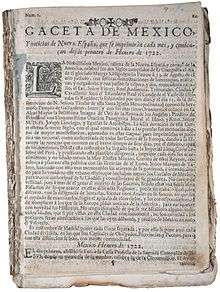La Gaceta de México
La Gaceta de México was a Spanish language newspaper published in Mexico. It was first published in 1722 making it first newspaper to be published in America. It was founded by Juan Ignacio María de Castorena Ursúa y Goyeneche, a journalist, Catholic priest, and later Bishop of Yucatan. He was evidently a Jesuit, as he was educated under Jesuit direction in the Colegial Real en el de San Ildefonso, and the Seminario de la Sagrada Compañía de Jesús de la Corte de México, and had many Jesuit associates.[1][2][3][4][5][6] He is considered the first journalist in Latin America for having created the periodical in Mexico City, whose first issue was published on January 1, 1722.[7] He was a friend of Sor Juana Inés de la Cruz, editing some of her works and defending her right to cultivate writing literature.[7]
 First issue on January 1, 1722 | |
| Founded | January 1, 1722. |
|---|---|
| Language | Spanish |
| Headquarters | Mexico City |
History of the Gaceta
In the eighteenth century a new form of periodical publication appeared: the gazette. Its objective was to provide information about Europe, the viceroyalty, arrival and departure of fleets and the publication of banns. The main gazettes were El Mercurio Volante, published by José Ignacio Bartolache, Diario Literario de México (Literary Journal of Mexico), Gaceta de Literatura de México and Asuntos Varios sobre ciencias y artes (Various Matters on Science and Arts), by José Antonio de Alzate y Ramírez.[8]
The Gazeta de México y noticias de Nueva España - used the "z" in its spelling in respect for the Italian spelling, since Gaceta is a word that derives from that language. The publication consisted of eight pages per issue, and six numbers appeared under that name, until June 1722. From the fourth issue it was called Gazeta de México y florilegio historial de las noticias de Nueva España. Originally, the publication was conceived to record the events that occurred in the viceregal court. The objective of its editor was to report on the most notable and praiseworthy events of the day, in order to provide this information to the public. It was framed within the cultural and educational aims of the Bourbon dynasty, that is, it was intended to spread European ideas and customs among readers.[7]
The Gaceta de México was the first newspaper published in Latin America. In the North American continent Publick Occurrences preceded it, with its only issue published September 25, 1690, in Boston. Later, in the Spanish America colonies, other newspapers were begun, all following the example of the Gaceta de Madrid. They included the Gazeta de Guatemala (1729), the Gazeta de Lima (1743) ), the Gazeta de la Habana (1764), the Gaceta de Santa Fe de Bogotá (1785), and the Primicias de la cultura de Quito (1792).[7]
Mexico's first Gaceta de México publication suspended publication six months after its first issue. However, a few years later another newspaper with the same name emerged, which began its publication on January 1, 1728. This consisted of four pages per issue, and its editor was Juan Francisco Sahagún y Arévalo Ladrón de Guevara. It lasted until December 1739, publishing a total of 145 issues.[7]
There was a third Gaceta de México, a compendium of news from New Spain, which emerged on January 14, 1784, and suspended publication on January 2, 1810. It was edited by the Creole Manuel Antonio Valdés y Munguía, a printer and the owner of a company of rental coaches. This third version of the Gazette was the longest running newspaper in the Mexican colonial era.[7]
References
- Amador, Elias. Bosquejo Historico de Zacatecas (in Spanish). 1. Escuela de Artes y Oficios en Guadalupe. p. 454.
- "La Gaceta de México, el primer periódico nacional". Bicentenario (in Spanish). Retrieved 21 June 2013.
- Frankie Hutton; Barbara Straus Reed (1995). Outsiders in the 19th-century press history: multicultural perspectives. Popular Press. p. 62. ISBN 978-0-87972-688-1. Retrieved 21 June 2013.
- James D. Henderson; Helen Delpar; Maurice Philip Brungardt; Richard N. Weldon (January 2000). A Reference Guide to Latin American History. M.E. Sharpe. p. 53. ISBN 978-1-56324-744-6. Retrieved 21 June 2013.
- Cheryl English Martin (1 November 2000). Governance and Society in Colonial Mexico: Chihuahua in the Eighteenth Century. Stanford University Press. p. 80. ISBN 978-0-8047-4168-2. Retrieved 21 June 2013.
- "La Prensa en America". Historia (in Spanish). 1 May 2010. Retrieved 14 September 2018.
- Fernández Delgado, Miguel Ángel. "La Gaceta de México" (in Spanish). Archived from the original on 8 November 2012. Retrieved 14 September 2018.
- Cid Carmona Víctor Julian, "Epítome bibliográfico de impresos médicos mexicanos, siglos XVI-XVIII," in Boletín Mexicano de Historia y Filosofía Médica, 2002; 5 (1) (in Spanish)